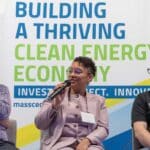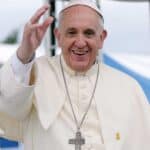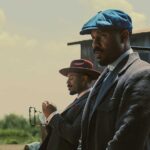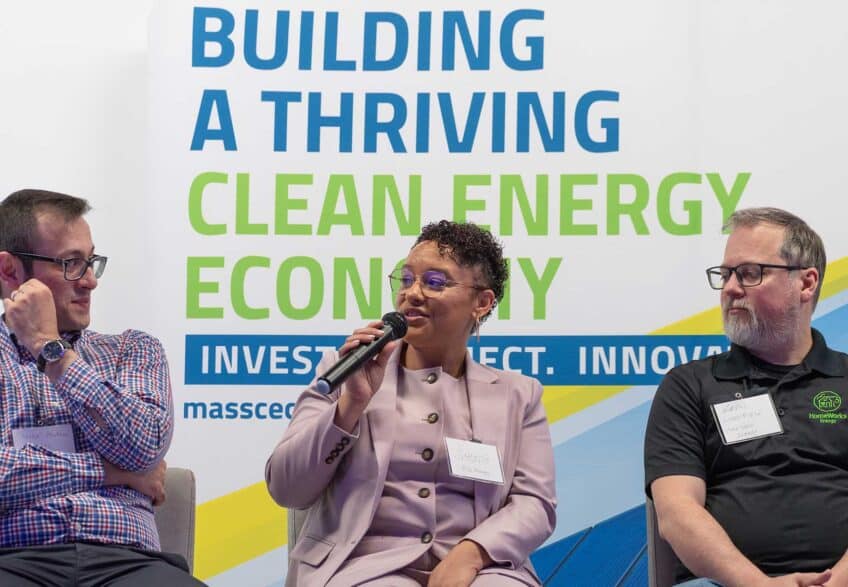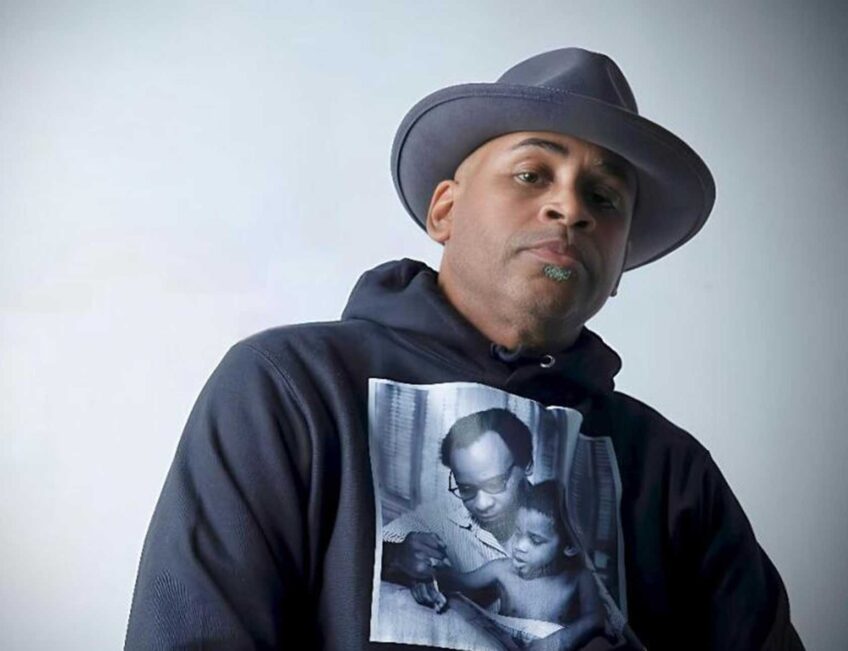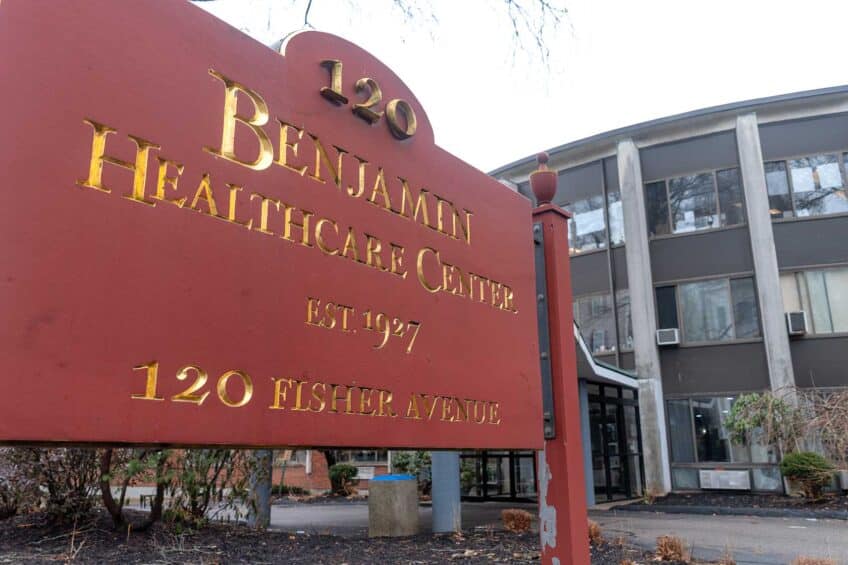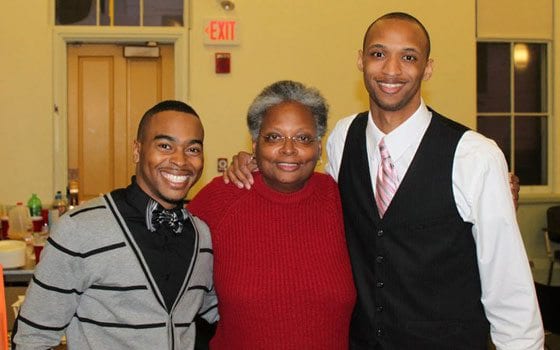

The Hispanic Black Gay Coalition (HBGC) founders Quincey Roberts (l) and Corey Yarbrough (r) are pictured with Mandy Carter, founder of the National Black Justice Coalition.
As Boston’s gay community prepares to kick off its 41st annual Pride celebration, the Hispanic Black Gay Coalition (HBGC) hopes its presence in this year’s festivities will add some new colors to the rainbow — black and brown.
“This year, we’re all about bringing black and brown faces to Pride,” said HBGC co-founder and CEO Corey Yarbrough. “We need people to realize that we’re a part of this community too, and we have value.”
Although a fairly new organization, HBGC has already made its presence known, and Boston Pride organizers took note, nominating the collective to serve as Group Marshal of this year’s Pride parade. While they weren’t chosen as marshal, they still see themselves as winners, especially since their talent showcase, to be held Friday, June 3 from 7 to 10 p.m. at Machine Nightclub, will serve as the official kick-off event for Boston Pride.
Not bad for a group of black, Hispanic and Latino LGBTQ folk who just a few years ago felt isolated from Pride, their unique perspectives as people of color virtually ignored by Boston’s mainstream (and mostly white male) gay community.
“I’ve never really participated in Pride, and I think it’s because I didn’t really identify with the gay community here,” Yarbrough said. “They weren’t quick to embrace me, I was apprehensive about embracing them, and so I just kind of stayed away from it.” HBGC hopes to bring not just new faces to this year’s Boston Pride, but a new approach to the celebration, one that’s educational, empowering and entertaining.
“[Boston Pride] was more like party, party, party with no workshops, no forums, [and] no educational aspect to it. I got turned off really quickly,” said Quincey Roberts, HBGC’s CFO and co-founder. “Both of our parents have always taught us if you don’t like something, change it.”
In addition to hosting the talent showcase, HBGC will also be promoting the AIDS Action Committee’s 26th annual AIDS Walk. Part of the proceeds from the talent show is going to the AIDS Walk, and that alone should be a reason why black and brown people, regardless of sexual orientation, need to come together, Yarbrough insisted.
“HIV/AIDS is an issue that greatly affects the gay community, greatly affects the black community [and] greatly affects the Latino community,” Yarbrough said. “Regardless of who you care about me sleeping with, we need to come together and save our race and save our community.”
Both the talent showcase and the AIDS Walk will feature appearances by Rodney Chester, who’s best known for his role as “Alex” on the groundbreaking television series “Noah’s Arc,” one of the first shows to positively portray black and brown gay characters dealing with the ins and outs of love and life.
Chester will serve as emcee of the talent showcase in addition to participating in Sunday’s AIDS Walk, which takes place June 5 at 9 a.m. at the DCR Hatch Memorial Shell on the Charles River Esplanade in Boston.
Several HBGC members say they are constantly challenging the stereotypes of what it means to be an LGBTQ person of color. “It was almost like when I came out, I had to choose: black or gay?” said Roberts.
“It’s a catch-22,” Yarbrough agreed. “Because the gay community is so white here, when you do come out as a black gay man, they automatically assume you want to be white, or you want to be a part of that community. I identify with both. One doesn’t necessarily come before the other. Both make me who I am.”
The duo started HBGC because they wanted to show both Boston’s mainstream gay community and the black, Hispanic and Latino communities from which its members spring that LGBTQ people have much to offer by way of giving back to the communities and cultures that bred them.
Yarbrough and Roberts founded HBGC in 2009 after they noticed that many LGBTQ groups were choosing style over substance, socializing over service. “We love to party, don’t get us wrong. But what’s next? What’s after that?” Roberts questioned.
Many of HBGC’s current members also felt the local LGBTQ scene for people of color was lacking a certain something. “I [took part in] some meet-ups, [but] that wasn’t very productive,” said Shaunya Thomas, secretary of HBGC’s board of directors. “It was very cliquey.”
Joseph Singletary had also been looking for a good gay-friendly group to get involved in, but could never quite find one that fit. “Honestly, it was a little bit difficult. I lost a little bit of my faith in the gay community,” he said.
Roberts and Yarbrough said they felt the same. After researching existing LGBTQ groups for people of color, the pair developed and disseminated a survey to their network asking them what they would like to see in an LGBTQ group for people of color. After reviewing the responses, the two and a small team of dedicated volunteers began launching projects, programs and events that run the gamut from recreational and informational to inspirational and influential.
Two years later, they’ve reached a level of visibility that’s put them in a prime position to impact and influence Boston’s gay community and communities of color for many years to come. “One of the main things I attribute to us being so successful so quickly [is] because we responded directly to the needs of the community,” Yarbrough said.
Dr. Kim Parker, a high school teacher, is a HBGC member. “HBGC is unapologetically a black and brown space, and I think that’s good,” Parker said. “[If you live] in the city, you need to have places where you [can] go and know that you’re going to be around people who look like you.”
As their AIDS Walk endorsement indicates, HIV/AIDS and STD prevention is a major part of HBGC’s platform, and they frequently host seminars and forums on HIV/AIDS prevention and awareness and offer rotating clinics where people can receive safe-sex information and get tested.
The organization also assists members with finding LGBTQ-friendly places of worship, holds spiritual growth groups for those seeking to study and discuss faith-based and religious perspectives and provides resources and reassurance, including one-on-one counseling and support groups, to those who are coming out.
Their community building events give members an opportunity to network and interact with each other and the public at large. They regularly mentor LGBTQ college students of color; hold monthly brunches; participate in gay-straight alliances; organize forums on combating homophobia; volunteer at local service agencies; host life management workshops on topics such as estate planning, home buying and job searching; and host a highly popular book club where members read and discuss LGBTQ literature and literary works by authors of color.
For its members, HBGC is as much a safe space as it is a way to be of service to their community. Singletary said, “It just made me feel better that there are people out here who do care and really do want the best for you.” Thomas feels similarly. “To me it’s a family. They’re my family,” she said.
Parker perhaps sums it up best: “For people of color who are LGBTQ in Boston, you have a family. You should come home. We are here for you.”

